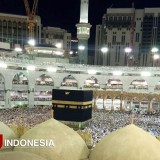TIMES AUSTRALIA, BANYUWANGI – Who is Al-Ghazali? He was a great Sufi figure, the author of the famous book Ihya' Ulumuddin.
This short article deliberately begins with a simple question and the answer is also short, concise, and true.
The author often asks the question above students to describe the great Islamic intellectual figure who was given the title "Hujjah al-Islam". And, their answer is very simple, as written above.
The author observes that there is an urgent problem that must be addressed in the memory of the students in depicting the figures of great Islamic scholars who have made great contributions in every era, such as Al-Ghazali. The students' short and simple answers indeed had multiple interpretations. This could be due to ignorance, minimal and lack of literacy insight, or due to inadequate historical knowledge. Literacy is a big problem currently in our Islamic boarding school world.
The world of Islamic boarding schools is known to be very familiar and is a repository of the intellectual property of past scholars. Hundreds or even thousands of yellow books have become the main reference (primary source) in solving and responding to humanitarian problems that occur.
This is where the urgency for students to research, explore, and then interpret the Islamic classical book (al-turats al-Islami al-salafi) is by its contemporary meaning so that it has transformative and implementative meaning.
Fazlur Rahman, a Muslim scholar from Pakistan, offers an interpretation model that should be appreciated by Islamic students. Rahman, who is a Professor of Islamic Studies at the University of Chicago, authored several monumental works in Islamic studies. Some of them are "Islam", "Islam and Modernity: Transformation of an Intellectual Tradition", "Revival and Reform in Islam", "Major Themes of the Qur'an" and others.
In several of his works, Rahman offers an interpretation model called double movement interpretation. First, from the present to the past. At this stage, a student is expected to be able to pay attention to current problems that occur using the variety of knowledge they have. Not only Islamic scholarship but also Western scholarship and its critical social analysis.
Delving into the past and lives of classical scholars is not to reminisce about their successes, but to understand and absorb their thought patterns in solving the problems that occurred in their time. This step is intended to understand the mindset, paradigm, methodology, and approach models they use so that they can reach the golden age of knowledge in their time. Apart from that, this effort was taken to obtain findings that were accurate and could be justified scientifically and ethically as they had been applied in the past.
Second, from the past to the present. The students' in-depth searches and research were then elaborated and explained in contemporary and contextual language. The mindset, paradigm, and methodology they use are of course not the same as those used by contemporary thinkers. However, not being the same doesn't mean it has to be thrown away or even abandoned. On the contrary, their valuable heritage must still be used, especially in ways that are appropriate and relevant to our contemporary conditions. While adding reading patterns and scientific reasoning that we have mastered in the contemporary era so that the resulting meaning is applicative, implementable, and transformative.
These two operational steps are taken to obtain contextual and progressive meaning and understanding. In Rahman's words, a santri's interpretation of classical Islamic texts will not only dwell on the normative-textualistic plane, but they will be able to come up with a model of interpretation that has ethical-moral-substantive nuances that are in line with universal human values.
Back to the matter of Al-Ghazali. If the students apply Rahman's reading model, the students' answers will look broad, comprehensive, and holistic.
If their literacy is broad and competent, they will be able to describe the figure of Al-Ghazali not only as a Sufi figure. Al-Ghazali is a multitalented Islamic thinker. He is an expert in fiqh (faqih), ushul fiqh (ushuly), theologian, the foremost defender of the Asy'ari school of thought (mutakalim), and an expert in philosophy (philosopher).
Al-Ghazali is known as a faqih as evidenced by his works in the field of fiqh such as Al-Wasit fi al-Mathab (The medium [digest] in the Jurisprudential School), Fatawa al-Ghazali (Verdicts of al-Ghazali), and others. other. Meanwhile, in the field of ushul fiqh, Al-Ghazali has worked such as Al-Mustashfa fi 'Ilm al-Ushul (The Clarified in Legal Theory), Asas al-Qiyas (Foundation of Analogical reasoning), Buku Tahzib al-Usul (Pruning on Legal Theory), and others.
In the realm of kalam (theology) scholarship, Al-Ghazali is famous for several of his works, Al-Munqidh min al-Dalal (Rescuer from Error), Al-Iqtisad fil-I`tiqad (Median in Belief), Al-Maqsad al-Asna fi Sharah Asma' Allahu al-Husna (The Best Means in Explaining Allah's Beautiful Names), Faysal al-Tafriqa bayn al-Islam Wal-Zandaqa (The Criterion of Distinction between Islam and Clandestine Unbelief), and others.
In the field of philosophy, Al-Ghazali is known for his magnum opus philosophical works: Maqasid al Falasifa (Aims of Philosophers) and Tahafut al-Falasifa (The Incoherence of the Philosophers). Some other works in this field are Al-Qistas al-Mustaqim (The Correct Balance), Mihak al-Nazar fi al-Mantiq (Touchstone of Reasoning in Logic), Miyar al-Ilm fi fan al-Mantiq (Criterion of Knowledge in the Art of Logic) and others.
As a Sufi, Al-Ghazali produced several works that would make his name famous in the future. Among them are Bidayat al-Hidayah (Beginning of Guidance), Ihya' Ulum al-Din, Kimiya-ye Sa'adat (The Alchemy of Happiness), Minhaj al-'Abidin (Methodology for the Worshipers), Mizan al-'Amal (Criterion of Action), and others.
Al-Munqidh min al-Dalal (Rescuer from Error) is a book that intersects three scientific disciplines, theology, philosophy, and Sufism. Why is that? In this book, Al-Ghazali describes some of his thoughts related to concepts in these three scientific disciplines.
Al-Muluk's Advice (Counseling Kings) is more directed towards political science, where in this work Al-Ghazali offers some of his thoughts in the field of politics and advice related to the world of politics.
Apart from those mentioned above, Al-Ghazali also authored several tafsir books such as Hujjat al-Haq (Proof of the Truth), Jawahir al-Qur'an wa Duraruh (Jewels of the Qur'an and its Pearls), Mishkat al-Anwar ( The Niche of Lights), and Tafsir al-Yaqut al-Ta'wil.
Before making his choice in the world of Sufism, Al-Ghazali was immersed in the struggle to find "truth". In the world of fiqh, Al-Ghazali found that the fuqaha of his time was trapped in a textual-formalistic meaning of Islam. They are only satisfied with the spiritual meaning of Islam. The resulting model of meaning is black and white, rigid, rigid, and has one-sided truth claims. As a result, claims of infidels, apostates, zindiq, fasiq, and so on are found scattered throughout their various works.
What Al-Ghazali discovered in the world of fiqh, he also experienced when he was involved in the scientific disciplines of theology, philosophy and Sufism. Even so, Al-Ghazali continued to follow his chosen path in life, not being satisfied with just mastering one scientific field.
The normative-textualist version of the fuqaha's version of truth cannot satisfy him in reaching the ultimate truth. He also felt that theology, which was full of one-sided truth claims, was unable to lead him to the truth he was looking for. He bypassed the scientific discipline of philosophy which relied too much on the power of reason by tearing apart the philosophical works of Al-Farabi and Ibn Sina. Until in the end, he concluded that the truth of philosophy was still unable to lead him to the real truth.
Amid his ongoing ijtihad, a speck of Divine light hit his deepest inner recesses. Sufism became his final choice and way of life in the arms of the True Truth.
The portrait of Abu Hamid bin Muhammad bin Muhammad Al-Ghazali Al-Thusy Al-Syafi'i is a portrait of a progressive Muslim who continues to work and search for the truth in his life. A progressive student who is always dissatisfied with the reality that occurs until he can offer solutions for humanity in interpreting and interpreting his life journey. A progressive Santri who is full of various approaches to interpreting Islam and its beliefs in every era in which he lives. (*)
***
*) Oleh : Moh Nur Fauzi, Lecturer in Islamic Studies at KH. Mukhtar Syafaat University Blokagung Banyuwangi.
*)Tulisan Opini ini sepenuhnya adalah tanggungjawab penulis, tidak menjadi bagian tanggungjawab redaksi timesindonesia.co.id
*) Kopi TIMES atau rubik opini di TIMES Indonesia terbuka untuk umum. Panjang naskah maksimal 4.000 karakter atau sekitar 600 kata. Sertakan riwayat hidup singkat beserta Foto diri dan nomor telepon yang bisa dihubungi.
*) Naskah dikirim ke alamat e-mail: [email protected]
*) Redaksi berhak tidak menayangkan opini yang dikirim.
**) Ikuti berita terbaru TIMES Indonesia di Google News klik link ini dan jangan lupa di follow.
Artikel ini sebelumnya sudah tayang di TIMES Indonesia dengan judul: Portrait of Progressive Santri and Double Movement Approach
| Writer | : Hainor Rahman |
| Editor | : Hainorrahman |

























